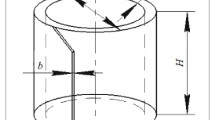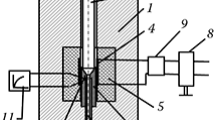Abstract
Various gas-quenching processes, including marquenching, were investigated to optimize gas-quenching processes in terms of distortion and hardness by means of numerical and experimental analyses. The temperature, microstructure, hardness, and distortion during the various gas-quenching processes of a tool steel block were simulated using a finite element method based on a coupled thermo-metallurgical–mechanical model. The predicted temperature, hardness, and distortion agreed well with the experimental data. The tool steel block (200 × 150 × 70 mm3) quenched under 10 bar pressure of nitrogen gas (Case 2) had higher hardness due to the higher martensite fraction and larger distortion owing to the higher thermal stress induced by faster cooling, compared to the block quenched under 2 bar pressure of nitrogen gas (Case 1). The tool steel block marquenched under 10 bar pressure of nitrogen gas interrupted by isothermal holding at 500 °C (Case 3) had 30% smaller distortion with a negligible loss of hardness compared to Case 2. Furthermore, the simulation results could provide an optimized process condition to minimize distortion of the gas-quenched tool steel block while satisfying the hardness requirement.











Similar content being viewed by others
References
G. Belinato, L.C.F. Canale, and G.E. Totten, Gas Quenching, Quenching Theory and Technology, 2nd ed., B. Liscic, H.M. Tensi, L.C.F. Canale, and G.E. Totten, Ed., CRC Press, Boca Raton, 2010, p 445–483
V. Heuer, Gas Quenching, ASM Handbook, Vol 4A, Steel Heat Treating Fundamentals and Processes, J. Dossett and G.E. Totten, Ed., ASM International, Materials Park, OH, 2013, p 221–231
A. Thuvander, Numerical Simulation of Gas Quenching of Tool Steels and the Influence of Hardenability on Distortion, in 6th International Tooling Conference, ed. by J. Bergström, 10-13 Sept 2002 (Karlstad, Sweden, 2002), p. 625–642
M. Kawano, Estimation of Thermal Distortion Through Numerical Analysis in Quenched JIS SKD61, Denki Seiko Electr. Furn. Steel, 2005, 76(4), p 293–298 (in Japanese)
Z. Li and R.V. Grandhi, Multidisciplinary Optimization of Gas-Quenching Process, J. Mater. Eng. Perform., 2005, 14(1), p 136–143
Z. Li, R.V. Grandhi, and R. Srinivasan, Distortion Minimization During Gas Quenching Process, J. Mater. Process. Technol., 2006, 172(2), p 249–257
H. Li, G. Zhao, C. Huang, and N. Shanting, Technological Parameters Evaluation of Gas Quenching Based on the Finite Element Method, Comput. Mater. Sci., 2007, 40(2), p 282–291
H. Li, G. Zhao, N. Shanting, and L. Yiguo, Technologic Parameter Optimization of Gas Quenching Process Using Response Surface Method, Comput. Mater. Sci., 2007, 38(4), p 561–570
F. Frerichs, T. Lübben, U. Fritsching, H. Lohner, A. Rocha, G. Löwisch, F. Hoffmann, and P. Mayr, Simulation of Gas Quenching, J. Phys. IV Fr., 2004, 120, p 727–735
J.F. Douce, J.P. Bellot, S. Denis, F. Chaffotte, G. Pellegrino, F. Gouhinec, P. Lamesle, and J. Maury, Coupled Fluid Flow, Heat Transfer, Phase Transformation, Stress and Deformation Numerical Model for Gas Quenching, Int. J. Microstruct. Mater. Prop., 2008, 3(1), p 150–161
G.E.P. Box and K.B. Wilson, On the Experimental Attainment of Optimum Conditions, Breakthroughs in Statistics, Springer, New York, 1992, p 270–310
ASTM International, Standard Practice for X-Ray Determination of Retained Austenite in Steel with Near Random Crystallographic Orientation, ASTM E975-00, ASTM International, West Conshohocken, 2003, p 1–6
J.C. Benedyk, High Performance Alloys Database, H13, CINDAS LLC, West Lafayette, IN, 2008, p 1–23
DEFORM™ version 11.0.2, Scientific Forming Technologies Corp., Columbus, OH, 2014
W.A. Johnson and R.F. Mehl, Reaction Kinetics in Processes of Nucleation and Growth, Trans. AIME, 1939, 135, p 416–442
M. Avrami, Kinetics of Phase Change I, General Theory, J. Chem. Phys., 1939, 7(12), p 1103–1112
A.N. Kolmogorov, A Study of the Equation of Diffusion with Increase in the Quantity of Matter, and its Application to a Biological Problem, Mosc. Univ. Bull. Math., 1937, 1, p 1–25
E. Scheil, Anlaufzeit der Austenitumwandlung, Steel Res. Int., 1935, 8(12), p 565–567 (in German)
F.M.B. Fernandes, S. Denis, and A. Simon, Mathematical Model Coupling Phase Transformation and Temperature Evolution During Quenching of Steels, Mater. Sci. Tech., 1985, 1(1), p 838–844
D.P. Koistinen and R.E. Marburger, A General Equation Prescribing the Extent of the Austenite-Martensite Transformation in Pure Iron-Carbon Alloys and Plain Carbon Steels, Acta Metall., 1959, 7(1), p 59–60
JMaPro Version 7.0.0, Sente Software Corp., Guildford, UK, 2012
P. Michaud, D. Delagnes, P. Lamesle, M.H. Mathon, and C. Levaillant, The Effect of the Addition of Alloying Elements on Carbide Precipitation and Mechanical Properties in 5% Chromium Martensitic Steels, Acta Mater., 2007, 55(14), p 4877–4889
M. Kang, G. Park, J.-G. Jung, B.-H. Kim, and Y.-K. Lee, The Effects of Annealing Temperature and Cooling Rate on Carbide Precipitation Behavior in H13 Hot-Work Tool Steel, J. Alloys Comp., 2015, 627(5), p 359–366
Acknowledgment
The authors are grateful to Seok-Won Son (Korea Institute of Industrial Technology) for his assistance with the gas-quenching experiments. SJL appreciates the support by the Industrial Technology Innovation Program funded by the Ministry of Trade, Industry, and Energy (MOTIE) through Korea Evaluation Institute of Industrial Technology (KEIT), Republic of Korea (N0001713).
Author information
Authors and Affiliations
Corresponding author
Rights and permissions
About this article
Cite this article
Jung, M., Lee, SJ., Lee, WB. et al. Finite Element Simulation and Optimization of Gas-Quenching Process for Tool Steels. J. of Materi Eng and Perform 27, 4355–4363 (2018). https://doi.org/10.1007/s11665-018-3492-6
Received:
Revised:
Published:
Issue Date:
DOI: https://doi.org/10.1007/s11665-018-3492-6




